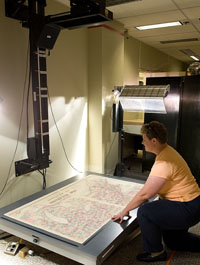This is the first of three "Challenge" articles on this project; the subsequent articles will provide more detail about the two working groups.
Saving the nation’s cultural heritage is an increasingly important matter for government agencies that hold large amounts of material documenting the national record. While saving traditional printed archival materials continues to be important, the exponential growth of digitizing projects has created a new set of challenges related to producing and preserving materials in digital format over the long term.

A map is prepared for digitization on a Jumbo Scanner in the Library’s Geography and Map Division.
Individual government agencies are digitizing different content, yet they share many of the same technical issues and concerns. So, the sharing of information and tools is an idea whose time has come. To that end, the Library of Congress is participating in a new government collaboration, the results of which can be followed on the newly released "Federal Agencies Digitization Guidelines Initiative" Web site www.digitizationguidelines.gov.
By making the federal agencies’ guidelines easily accessible, the aim is to encourage further collaboration among federal agencies, while allowing other organizations and the public to benefit. Michael Stelmach, manager of Digital Conversion Services for the Office of Strategic Initiatives (OSI) at the Library and a key organizer of this group, said: "We are hoping that by making our draft guidelines public and highlighting our priority challenges, we will encourage input from across the broader imaging community."
Feds to Standardize Digitization
Twelve agencies have come together to develop a common set of digitization practices and guidelines.
To deal with different types of formats, two working groups have been formed. A still-image working group will establish appropriate guidelines for the scanning of text, maps, photographic prints and negatives. An audiovisual working group will set standards for digitizing audiovisual materials—sound recordings, videos and film. They will post their recommendations on two Web sites:
www.digitizationguidelines.gov/still-image/ and www.digitizationguidelines.gov/audio-visual/.
These guidelines, which cover such criteria as evaluating image characteristics and establishing metadata elements, will serve not only the agencies, but also digitization service providers, equipment manufacturers, and other technologists. The products of the working groups are not considered to be static, but will continue to be updated and posted to the Web site.
Federal Members
Although the Library has served as convener during the formative stages, no one institution is a leader in this collaborative effort. Joining the Library are the Defense Visual Information Directorate, National Agricultural Library, National Archives and Records Administration, National Gallery of Art, National Library of Medicine, National Transportation Library, Smithsonian Institution, U.S. Geological Survey, the U.S. Government Printing Office and the Voice of America.
"All the government agencies are in a similar situation; there are certain types of materials that you know exactly what to do with," said Steve Puglia, preservation and imaging specialist for the National Archives, and involved in this effort. "In the still-imaging area, there are certain baseline approaches that already work well. One challenge we are currently facing is to create good procedures for quality assurance and quality control. Fixing things upfront in the process is really important, and will result in the best-quality final product."
By combining forces, participating agencies expect to save time and resources. James Mauldin, manager of the Office of Archival Management at the Government Printing Office, acknowledges the benefits of this effort for his agency. In addition to the document specifications already used by the GPO, Mauldin says that "working collaboratively with other agencies will provide greater coverage of all types of documents, such as maps, medical diagrams, and posters."
The audiovisual working group will draft comprehensive guidelines for the digital reformatting of sound recordings, building on a number of efforts carried out by federal agencies and others in recent years. Here, the working group will consider guidelines such as criteria for selection of digital file formats—called target formats—that are suitable for preservation.
Other Web Site Resources
In addition to the guidelines, other resources are available on the Web site. One of these is a glossary of digitization-related terms—a wide-ranging list of more than 200 terms and definitions, from common terminology, such as megapixel, to the more arcane, such as scotopic sensitivity. In addition, more than 500 other terms have been identified for future updates, so look for the list to grow into a comprehensive one-stop glossary for digitization.
The site also provides a link to a compendium of information about "Sustainable Formats," containing information on more than 200 current and emerging digital formats described in great detail.
The "News and Events" section of the site features recent news pertaining to digitization and currently includes an RFP from the Government Printing Office, as well as news of a collaborative project between the Library of Congress and Xerox Corporation.
A number of specialized resources can be found under both still-image and audiovisual sections. Each group has provided bibliographies, which are essentially lists of recent guidelines used by institutions in the United States and around the world. These provide a wealth of information about existing practices, and will be updated periodically.
One of the major goals of this project is to gather continuous feedback, and links for comments appear throughout the site. By encouraging interaction with the public, manufacturers, libraries, other agencies and organizations, it is hoped that these materials will grow even more robust over time. As summed up by Puglia of the National Archives: "The more open the process, the more feedback we can get from all communities, then the better off we are going to be."
